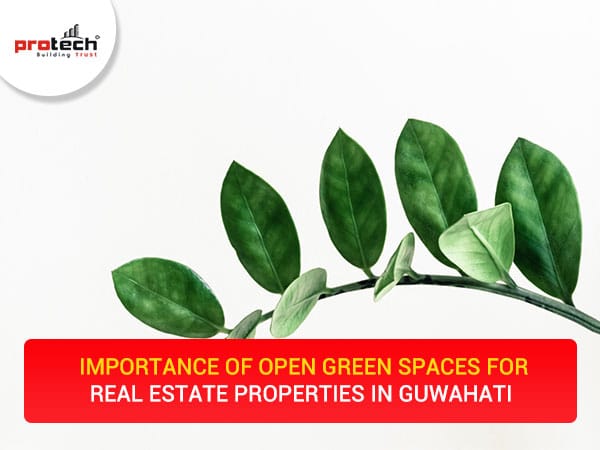Introduction
Open green spaces, such as public parks, gardens, and other similar areas, are critical for the physical and mental well-being of individuals and the community. The significance of open green spaces in the real estate sector cannot be overstated. Especially in a city like Guwahati, which is rapidly expanding.
In recent years, the importance of open green spaces in urban areas has been increasingly recognized. As cities become more crowded and urbanization continues to grow, it is becoming more important to prioritize the creation of open green spaces in real estate developments in big cities.
1. Why having open green spaces must be a Priority for Guwahati Real Estate Developers
Properties that are located near parks or other green spaces are deemed more desirable and have higher property values. These spaces not only enhance the residents’ quality of life but also foster a sense of community and encourage social interaction among neighbors. This blog aims to examine the importance of open green spaces in real estate properties in Guwahati and discuss their positive impact on the residents’ lives.
2. Personal health benefits of open green spaces
Access to green spaces has been linked to numerous health benefits, both physical and mental. Studies have shown that exposure to nature can reduce stress levels, improve mood and cognitive function, and even lower blood pressure and heart rate. In a big city where people are often living in small apartments or working in high-stress environments, having open green spaces nearby can provide a much-needed respite and improve overall quality of life.
Additionally, green spaces in urban areas can help improve air quality by filtering pollutants and reducing carbon emissions. Trees and plants absorb carbon dioxide and other pollutants and release oxygen, which can help reduce the impact of air pollution on human health. This can be especially important in big cities, where air pollution can be a major health concern.
3. Environmental Benefits of Open Green spaces

Urban heat islands result in increased daytime temperatures, decreased nighttime cooling, and elevated levels of air pollution. These factors contribute to illnesses and deaths related to heat, such as respiratory difficulties, heat cramps, heat exhaustion, and non-fatal heat stroke. In comparison to the surrounding rural areas, urban areas tend to be warmer by 1-7°F during the day and up to 5°F at night. While urban heat islands can positively impact biological activities like growing season length and reducing ice and snow in winter, they also cause discomfort during the summer and lead to heat-related stress and fatalities during heat waves.
4. Social Benefits of Open Green Spaces
Open green spaces can also serve as gathering places for community events and activities, which can help foster a sense of community and social cohesion. This is especially important in big cities, where people may feel disconnected from their neighbors and communities.
Overall, creating open green spaces in real estate developments in big cities can have numerous benefits for both residents and the city. By incorporating green spaces into their projects, developers can create more livable, sustainable, and vibrant communities.
5. Open Green Spaces in housing societies Improves Quality of Life

The inclusion of green spaces in housing projects can significantly improve the quality of life for the residents in Guwahati. It can provide numerous benefits such as improved physical and mental health, reduced environmental impact, and a more livable and sustainable environment. Therefore, it is important to prioritize green spaces in urban planning and development to create a better future for the city and its residents.
Open green spaces can also provide opportunities for education and learning. These spaces can be used to teach people about the natural environment, local history, and cultural heritage. This can be especially important for children, who may not have many opportunities to learn about nature and the environment in urban areas.
6. Enhances Aesthetic Appeal

Green spaces in housing projects can enhance the aesthetic appeal of the neighborhood, making it more attractive and livable. This can increase property values, making it a more desirable place to live, work, and visit. By ensuring that open green spaces are well-maintained, developers can contribute to the overall attractiveness and livability of the community.
7. Open Green spaces can help in lowering electricity bills
The Urban Heat Island (UHI) effect is a phenomenon where urban areas experience higher temperatures compared to rural areas due to human activities. Green spaces in housing projects can reduce the UHI effect by providing shade and cooling through evapotranspiration. This, in turn, can reduce energy consumption for cooling in homes, leading to lower electricity bills and reduced greenhouse gas emissions.
Conclusion
In conclusion, we can say that open green spaces are essential for urban areas as they provide numerous benefits to the residents and the environment. In Guwahati, the shortage of green spaces is a major concern as it leads to several problems such as air pollution, heat islands, and an increase in the urban heat island effect. With the city’s rapid growth, the demand for housing has also increased, leading to a decrease in the availability of open spaces. Therefore, it is crucial to include green spaces in housing projects to promote a healthy and sustainable living environment.

